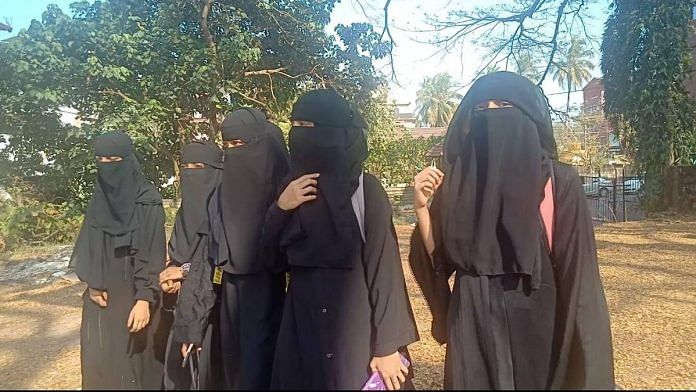The protest by a few young women Muslim students against the prescribed school uniform and insistence on wearing the hijab in a remote coastal Karnataka school of Udupi has now become a national debate. This is probably the first acid test for the Karnataka chief minister Basavaraj Bommai. Going by the extensive publicity and wide traction that the protests have garnered, the hijab storm could be a premeditated controversy rather than a mere unplanned incident.
The spread of protests to other parts of Karnataka has prompted the state government to declare a three-day holiday for schools and colleges to deescalate the situation.
The Karnataka High Court bench has said that the educational institutions should be reopened at the earliest and advised students to follow the dress code as stipulated by the school administration till the next hearing in the case. As of now, neither hijab nor saffron scarf should be insisted upon by the students, as per the court directive.
Also read: Viral photos, bruised egos, radical student groups: Inside story of Karnataka’s hijab crisis
A history of clashes
Like all state governments, Karnataka too has a structured information gathering system, local information bureau which is expected to keep a close watch on people, and events that are likely to unfold into serious law and order issue. Karnataka has had a history of religion related clashes in the past. The Hubli Idgah Maidaan riots; 2015 clashes in Shimoga; violence in Arisikere and Dharwad; 1986 riots in Mysore; 1990 riots in Kolar; 1993 riots in Bhatkal (close to Kundapur) and riots in Bhadrawati, Bengaluru, Haasan, Suratkal, only to name a few.
The coastal areas of Karnataka appear to have been always on a short fuse. Basavaraj Bommai, then home minister of Karnataka, had warned in 2019 about terrorist sleeper cells being active in Bengaluru and Mysuru and that their activities having intensified in coastal regions of the state. He had even said that the National Investigation Agency (NIA) suspected the movement of terrorists belonging to the Jamat-ul-Mujahideen Bangladesh (JMB) in coastal Karnataka and even in few interior areas of the state. The NIA had interrogated one Jufri Jawhar Damudi, arrested from Bhatkal in coastal Karnataka in August last year. He was in charge of recruiting students and youth for ISIS activities. In December 2021, security agencies were put on high alert after they received intelligence inputs about terrorist sleeper cells being activated by Indian Mujahidin (IM) that had a well-knit unit in Bhatkal.
Also read: The real issue in Karnataka hijab row is how secularism is defined wrongly – Nehru to Modi
Act if lapses occurred
In a highly sensitive region like coastal Karnataka, the police and state and the Union home ministry officials should have been extra vigilant and forewarned the state officials of an impending trouble. If they have failed to do so, the lapses should be investigated and those responsible penalised. And if the information was made available and yet the state officials remained negligent, heads must roll.
The hijab row is being projected as violation of the fundamental rights of Muslim women while it appears to be a pretext to fuel radicalism and create perennial flash points in and around educational institutions. Social Democratic Party of India (SDPI), the political outfit of the Islamic organisation Popular Front of India (PFI), is believed to be active in the coastal areas of Karnataka, especially after winning six seats in the local body elections in December last year. Its students’ wing, the Campus Front of India (CFI) is also said to be very active since then. It is not a coincidence that these outfits have intensified their protests demanding hijab to be allowed. The rival organisations apprehend that hijab demand will be followed by separate seating arrangements and even permission for offering namaz in school premises.
Meanwhile, with major political parties, their leaders and social media adherents jumping into the controversy, the issue seems to have crossed the state boundaries and received global attention. Wonder if it has the potential to influence the voters on religious lines in the ongoing assembly elections in five states. CM Bommai and his party should worry even more as the assembly elections in Karnataka are just a year away.
The immediate task of the chief minister should be to put in place a damage control mechanism. Once the schools reopen, the issue is bound to get re-ignited and trouble may spread to a larger area. The hijab incident has the potential to deeply polarise students on religious lines and also create an atmosphere for anti-social elements to infiltrate into the protesting groups. At a time when examinations are round the corner, the economy is limping back to normalcy and the state has other urgent developmental issues to address, such incidents must not be allowed to hijack the growth agenda.
The author is the former editor of ‘Organiser’. He tweets @seshadrichari. Views are personal.
(Edited by Anurag Chaubey)



